Choosing the Best Lifting Sling: Wire Rope vs. Chain. vs. Synthetics
Chain slings, wire rope slings, web slings, roundslings, synthetic rope, and metal mesh slings can all be used to safely and efficiently lift and position a load. But, choosing the right type of lifting sling is dependent on a complete understanding of the application, the environment it’s being used in, and how the sling will be used to support and lift the load.
Are you planning your next overhead lifting project and unsure about the best type of lifting sling to use? Or, maybe you’re not getting the service life you would expect out of the slings that you’re currently using? Alloy chain slings, wire rope slings, synthetic slings, and metal mesh slings can all be used to safely and efficiently lift, move, and position a load.
But, choosing the right type of lifting sling is dependent on a complete understanding of the application, the environment it’s being used in, and how the sling will be used to support and lift the load.
In order to have a balanced lift, you need to know the following:
- Weight of object to be lifted
- Center of gravity
- Number of attachment points
- Hitch type
- Geometry of lift including sling angles
- Reach
- Clearance – any height restrictions
- Upper and lower fitting requirements
- Ambient conditions

At Mazzella, we provide ideal lifting solutions—offering all styles of lifting slings, rigging hardware, wire rope, overhead cranes and hoists, and engineered lifting devices. Our goal for this article is to help you understand the basics of overhead lifting slings and provide you with the advantages and disadvantages of each type so you can make an informed decision and select the best lifting sling for your particular application.
Wire Rope Slings
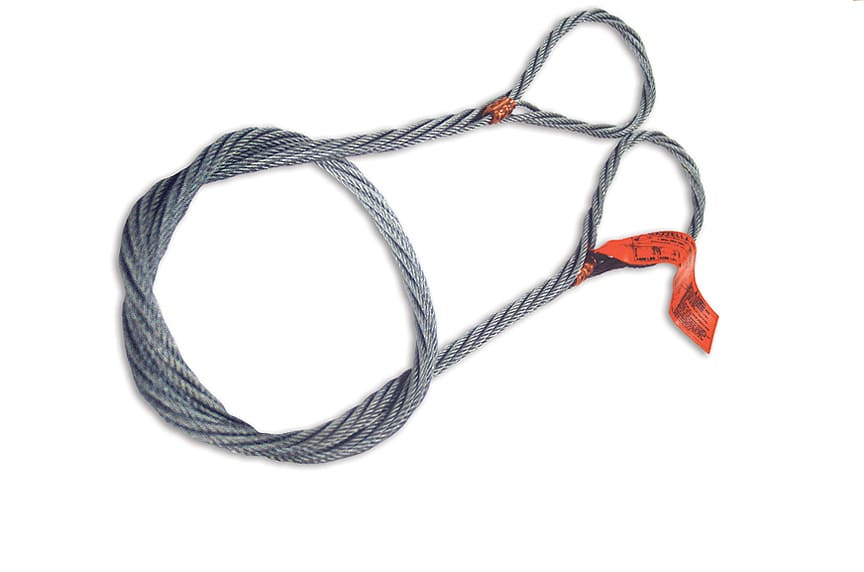
Wire rope is a preferred lifting device for many reasons. Its unique design consists of multiple steel wires that form individual strands laid in a helical pattern around a fiber or steel core. This structure provides strength, flexibility, and the ability to handle bending stresses.
Wire rope slings are popular in construction, automotive, oil and gas, and general manufacturing industries where a variety of heavy loads and rugged conditions exist. They’re also very popular in steel mills and forging facilities where the durability of the rope is really put to the test.
Different configurations of the material, wire, and strand structure will provide different benefits for the specific lifting application—including abrasion resistance, strength, flexibility, and fatigue resistance. Wire rope slings have a lower initial cost than alloy chain, while remaining fairly lightweight in design.
Wire rope slings are available in single-leg or multi-leg assemblies and can be used in a variety of hitches including vertical, choker, and basket hitches. The Design Factor for wire rope slings is a 5:1 ratio, meaning the breaking strength of the sling is five times higher than the rated Working Load Limit (W.L.L). Per the Wire Rope Users Manual, a design factor is necessary to allow for conditions such as wear, abrasion, damage, and variations in loads which are not readily apparent. Although wire rope slings have a design factor, the user should never exceed the rated Working Load Limit.
Advantages of Using Wire Rope Slings
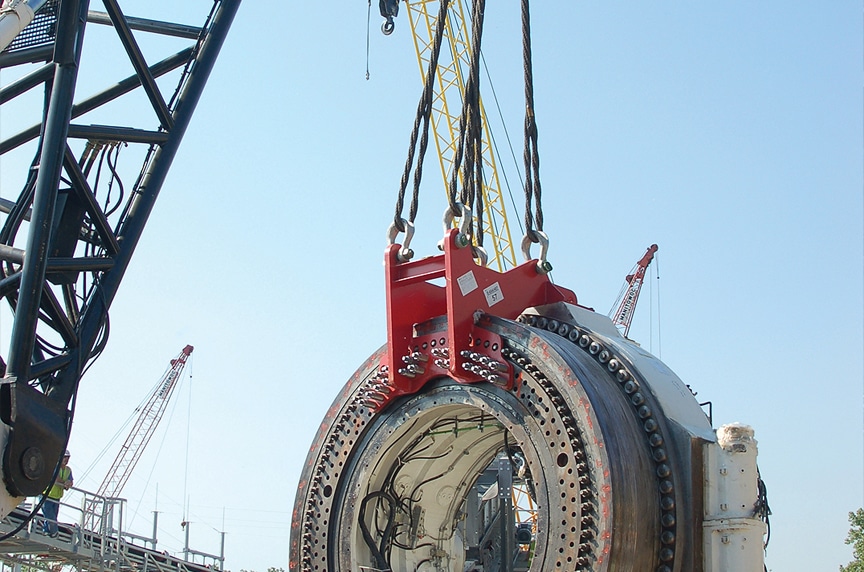
- Lower initial cost and lighter in weight than alloy chain slings
- High strength and flexibility in a smaller diameter design
- Different designs and constructions of wire rope provide:
- Strength
- Flexibility
- Abrasion resistance
- Fatigue resistance
- Corrosion resistance
- Braided or multi-part slings:
- More resistant to kinking than single-part slings
- Have high flexibility
- Snug up tightly around the load in choker hitches
- Quickly regain their original shape after a lift
- Can be used in vertical, choker, and basket hitches
- If the wire rope on sling bridles is damaged, the hardware (master links and hooks) can be re-used—provided that the hardware itself is not damaged.
Disadvantages of Using Wire Rope Slings
- Low strength to weight ratio
- Construction can make it difficult to inspect—especially in and around the core
- Misuse or abuse can cause kinking, crushing, or abrasion—resulting in structural damage and loss of strength
- Not repairable – if it is removed from service, best practices should be followed to destroy and dispose of the sling
- Can be susceptible to internal and external corrosion
- Trade-offs exist between the design and construction: a rope that is more abrasion resistant will offer less fatigue resistance—and vice versa
- Steel core slings should never be used at temperatures above 400°F or below -40°F.
Alloy Chain Slings
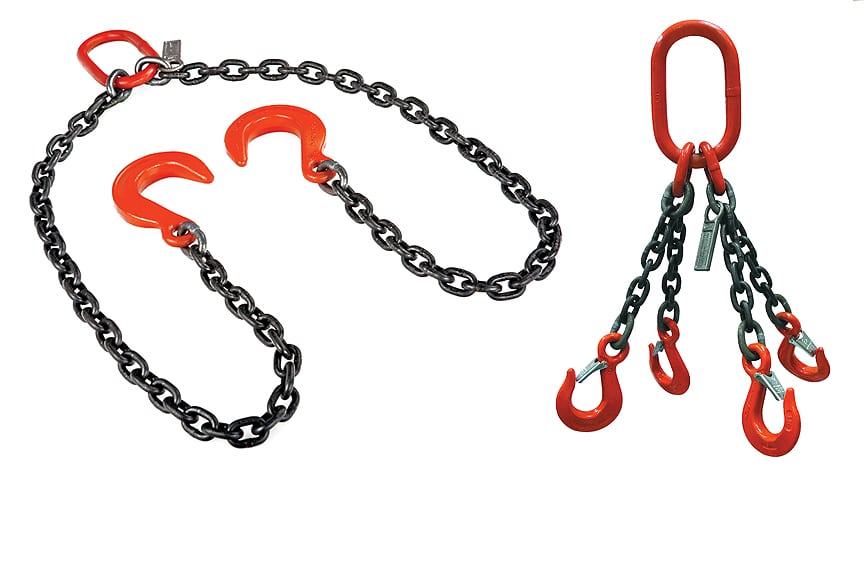
When it comes to toughness and dependability—alloy chain slings are the bulldogs of lifting slings. Chain slings can be used to lift very heavy and bulky loads on a regular or repetitive basis. Their flexible design provides strength and durability so they can withstand impact, extreme temperatures, and exposure to chemicals and UV rays.
Chain slings are preferred in high-temperature applications and for lifting heavy-duty loads. Their strength and durability allow them to be used in foundries, steel mills, heavy machine shops, and any other environment where repetitive lifts or harsh conditions would damage or destroy a wire rope sling or synthetic nylon or polyester sling. If any damage does occur on a chain sling, they are completely repairable and can be load tested-and re-certified after the repair.
Alloy chain slings can be heated up to temperatures of 1000°F, however the Working Load Limit must be reduced in accordance with the manufacturer’s recommendations when continually exposed to temperatures above 400°F.
Chain slings can be configured in single-leg, 2-leg, 3-leg, and 4-leg designs. They can be configured for use in vertical, choker, or basket hitches and a variety of different sling hooks, lengths of chain, and master links can be used to create different sling assemblies for different applications.
While there are many different types of chain, alloy steel grades 63, 80, and 100 are normally recommended for overhead lifting. In some applications, chain slings made of material other than alloy steel may be used. These applications involve a corrosive or high-temperature environment. The chain material in these unique applications is often stainless steel or some other special material chain. If non-alloy chain is used for lifting, we recommend that the user document the reason for using chain other than alloy, and also follow all appropriate chain sling standards including sling identification and inspection.
The Design Factor for chain slings is a 4:1 ratio, meaning the breaking strength of the sling is four times higher than the rated Working Load Limit. Although chain slings have a design factor, the user should never exceed the rated Working Load Limit.
Advantages of Using Alloy Chain Slings
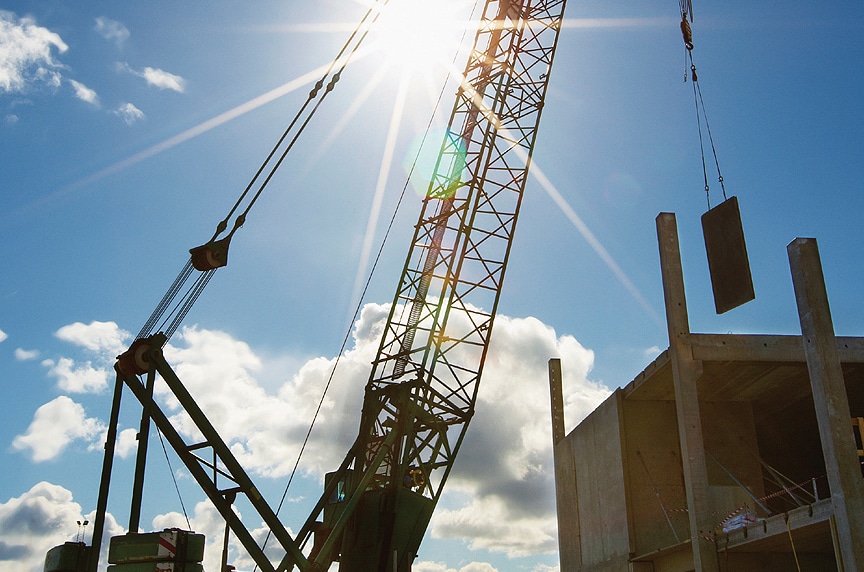
- High-strength, durable, and flexible design holds up in the harshest operating environments
- Completely repairable by replacing individual chain links or link segments
- Chain slings are easy to inspect, proof-test, and re-certify in the event they are repaired
- Can be used at relatively high temperatures and in hazardous environments where other slings would be damaged or destroyed
- Resistant to corrosion, chemicals, and UV exposure
- Not affected by dirt, oil, or grease
- Will elongate 15-20% when overloaded to give a visual indicator that they have been overloaded and need to be destroyed and removed from service
Disadvantages of Using Alloy Chain Slings
- Very heavy – the higher the W.L.L. is, the heavier the chain will be
- Can be more expensive than wire rope or synthetic slings
- Can easily damage or crush sensitive or finished parts

Synthetic Slings

For highly finished parts or delicate equipment, nothing beats the flexibility, strength, and support that synthetic lifting slings can provide. Synthetic slings can be made from nylon or polyester materials and are lightweight, easy to rig, and extremely flexible. They’re extremely popular in construction and other general industries because they’re fairly inexpensive, come in a variety of standard sizes, and can be replaced easily.
Because they’re so flexible, they can mold to the shape of delicate and irregularly-shaped loads, or be used in a choker hitch to securely grip loads of round bar stock or tubes. The soft materials they’re made from are strong enough to lift heavy loads, but will protect expensive and delicate loads from scratches and crushing. Synthetic slings are extremely versatile, can be used in vertical, choker, and basket hitches and have a Design Factor of 5:1, meaning the breaking strength of the sling is five times higher than the rated Working Load Limit.
Because they’re made of non-sparking and non-conductive fibers, they can be used in explosive atmospheres. However, they’re also more susceptible to cuts, tears, abrasions. Exposure to heat, chemicals, and UV rays can also cause damage and weaken the strength and integrity of the sling.
In most cases, synthetic slings cannot be repaired, so any evidence of damage is cause for removal from service. Best practice is to destroy and dispose of damaged synthetic slings to prevent further use.
Advantages of Using Synthetic Slings

- Inexpensive and lightweight design makes them attractive to almost any industry or lifting application
- Made of soft, flexible materials that grip and mold to the shape of irregular loads
- Strong enough to lift heavy loads but will protect expensive and delicate loads from scratching and crushing
- A variety of materials, construction, and specifications can tailor synthetic slings to almost any lifting application
Disadvantages of Using Synthetic Slings
- Synthetic slings have a relatively low heat-resistance and are not recommended for use in high-heat applications
- Special considerations must be made when selecting a synthetic sling to be used in chemical applications. Nylon and polyester slings have different resistance characteristics to acidic and alkaline environments.
- Synthetic slings are not as durable as steel slings when it comes to abrasion and cut resistance. Corner protectors or edge guards should be used to protect against cuts and tears.
Synthetic Web Slings
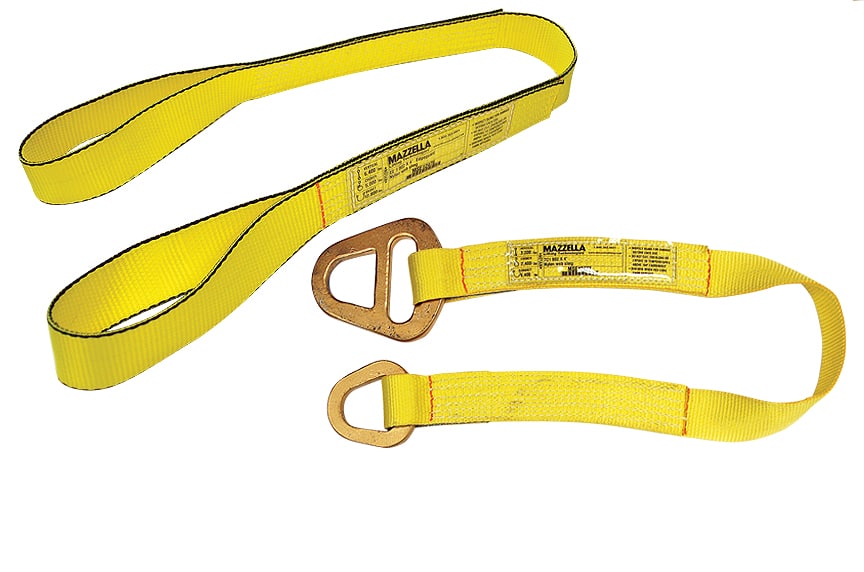
Web slings are flat belt straps made of webbing material and most commonly feature fittings, or flat or twisted eyes, on each end. Web slings are the most versatile and widely-used multi-purpose sling. They’re strong, easy to rig, and inexpensive. Compared to alloy chain slings, they’re more flexible and lighter and can be used to help reduce scratching and denting to loads. They can also be fabricated with wide load-bearing surfaces up to 48” to provide significant surface contact for heavy and large loads.
Nylon web sling performance isn’t affected by oil and grease, and they’re resistant to alkaline-based chemicals. However, they should never be used in acidic atmospheres or near chemicals used as bleaching agents. Polyester web slings can be used in acidic environments or near chemicals used as bleaching agents, but should never be used in alkaline environments.
They also have a relatively low heat-resistance and are not to be used in environments that exceed 194°F, or environments where temperatures are below -40°F. For loads with sharp edges, corner protectors or edge guards should be used to protect the sling from cuts and tears. Because there is a difference between abrasion-resistant protection and cut-resistant protection, be sure to identify the type of resistance required for your application.
If used outdoors, they should be stored away in a cool, dark, and dry environment to avoid prolonged exposure to sunlight and UV rays, which can damage and weaken the strength of the sling. When a lift is made at the W.L.L., the user can expect approximately 8-10% stretch when using a nylon web sling and 3% stretch when using a polyester web sling at rated capacity.
Synthetic Roundslings

Endless roundslings have load-bearing fiber or core yarns that are protected by a woven outer jacket. They are strong, soft and flexible, and protect smooth or polished surfaces from scratches, dents, and crushing. Roundslings can be used in vertical, basket, or choker hitches—which are especially useful for lifting tubes and pipes.
The woven outer jacket is designed to protect the internal load-bearing fibers and core yarns against abrasion, dirt and grease, and UV degradation. Polyester roundslings are suitable for acidic environments, or near chemicals used as bleaching agents, but should not be used in alkaline environments.
Like web slings, roundslings are more susceptible to heat damage and should not be used in environments that exceed 194°F or below -40°F. For loads with sharp edges, corner protectors or edge guards should be used to protect the sling from cuts and tears.
If used outdoors, they should be stored in a cool, dark, and dry environment to avoid prolonged exposure to sunlight and UV rays, which can damage and weaken the strength of the sling. When a lift is made at the W.L.L., the user can expect approximately 3-5% stretch when using a roundsling.
Synthetic Twin-Path® Roundslings

A number of high-performance and lightweight roundslings are available for industrial and heavy lifting applications—including steel, energy, automotive, and manufacturing. Twin-Path® roundslings have the precision and flexibility to perform heavy lifting jobs quickly and safely and only weigh 10% of the total weight of a comparable steel sling. High-performance roundslings come in standard vertical lifting capacities up to 500,000 lbs., and can also be special-ordered to handle larger capacities. These slings have less than 1% stretch at rated capacity.
Unlike standard roundslings, Twin-Path® roundslings utilize two paths of K-Spec® load-bearing fibers. The Twin-Path® patented design provides the rigger with two connections between the hook and the load for redundant back-up protection. They also feature other technologies like a Check-Fast® inspection system and an External Warning Indicator (EWI) that can provide visual indications of overloading, UV damage and degradation, or damage to the internal core fibers.
Twin-Path® slings are susceptible to cuts and tears to the jacket when used to support loads with sharp corners or edges. The specially-designed Covermax® Cover provides the best ultraviolet (UV) protection and the best abrasion protection of any commercially available synthetic lifting sling. CornerMax® Pads and CornerMax® sleeves are extremely cut resistant and can be used to protect the Twin-Path® slings in applications where cutting is a concern. If the outer jacket is cut or torn, and the load bearing fibers are not cut, Twin-Path® slings are repairable by applying a patch and proof-testing the sling after the repair is performed.
Standard Twin-Path® slings are also susceptible to heat damage, and should not be used in high heat environments above 180°F. Specially-designed slings are available with high-temperature core yarns and a high temperature cover that is resistant to temperatures up to 300°F.
Synthetic Rope Slings

Although synthetic rope slings have been in use for over sixty years, the advancement of high-performance fibers has recently improved the perception of using rope slings for overhead lifting applications. These high-performance fibers are characterized by their light weight, strength, flexibility, and versatility. Not only are they becoming more widely-accepted, but are preferred in certain lifting applications in the construction, shipyard, and offshore and deepwater industries. Because there are various types of synthetic rope material, it’s critical to know the specific fiber that a rope is made from to help understand its environmental characteristics.
Diameter to diameter, a synthetic rope sling is approximately 1/8 the weight of a steel wire rope sling with similar specifications, and compared to chain slings, they offer even more significant weight-savings.
Another major benefit of synthetic rope slings, is that if a break or failure occurs, there is no whipping motion of the sling or projectiles that could injure nearby workers. When a steel rope or chain breaks, the reaction is often violent and explosive and can potentially injure workers or damage nearby equipment.
Synthetic rope slings are more prone to damage from abrasion or cutting when lifting loads with sharp corners or edges. Additional edge protection and abrasion protection is available, but can add significant costs to the slings to try and equal the durability and resistance that more traditional steel slings offer.
Advantages of Using Synthetic Rope Slings

- The major benefit of using synthetic rope is the significant weight-savings it offers to the end-user versus metal slings
- Being ultra-flexible and strong, high-performance synthetic ropes will not experience crushing, bending fatigue, or kinking
- Depending on the type of fiber, some newer technology synthetic ropes can be used outdoors in harsh elements (UV exposure, rain, snow, freezing temperatures), in chemically-active environments, and are neutrally-buoyant so they can be used in freshwater or saltwater environments. Consult the sling manufacturer or a Qualified person to confirm how a specific sling material may react to sunlight, UV, or chemicals.
Disadvantages of Using Synthetic Rope Slings
- Synthetic rope is not as durable as steel slings in that they will experience cutting, fraying, and abrasion if used to lift loads with sharp edges
- Additional edge or cutting protection can increase the cost of individual rope slings
- Some synthetic rope sling material may be susceptible to chemically active environments or exposure to sunlight or UV light. Consult the sling manufacturer or a Qualified person to confirm how a specific sling material may react to sunlight, UV, or chemicals.
Metal Mesh Slings

Metal mesh slings are made from high-tensile carbon, alloy, or stainless steel wire mesh and are used primarily in metalworking and other industries where the loads can be hot, abrasive, or have the tendency to cut through softer synthetic slings. They’re resistant to corrosion and they’re designed to last in demanding and rugged operating environments.
Metal mesh slings are flexible and have a wide bearing surface that can be used to firmly grip an irregular load without extensive stretching and can be used in vertical, basket, or choker hitches. They’re extremely resistant to abrasion and cutting, however if there is evidence of even one broken wire in the sling, the entire sling needs to be removed from service. The Design Factor for wire rope slings is a 5:1 ratio, meaning the breaking strength of the sling is five times higher than the rated Working Load Limit. Although metal mesh slings have a design factor, the user should never exceed the rated Working Load Limit.
Advantages of Using Metal Mesh Slings
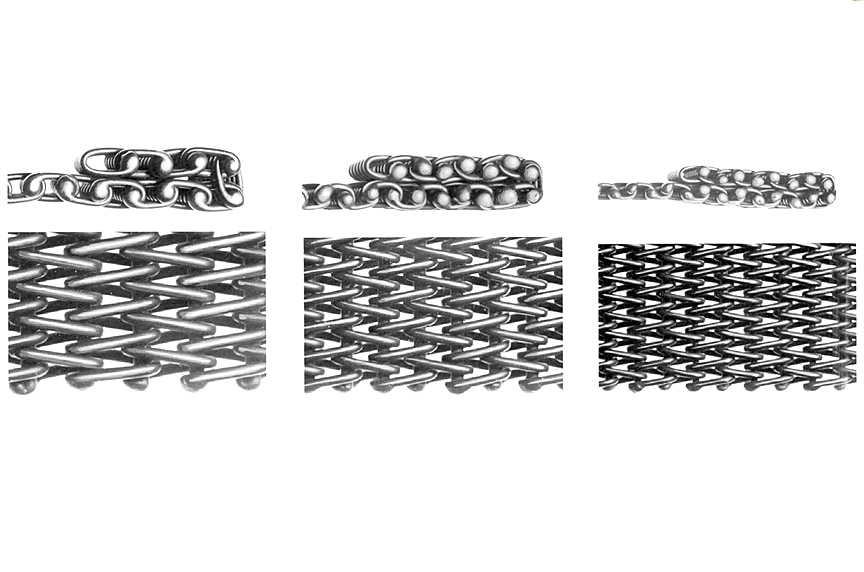
- High-strength and durable design protects against corrosion, abrasion, and cutting
- Can be used in metalworking and other high-heat and demanding environments
- Flexible design with a wide bearing surface that can firmly grip irregular loads—similar to synthetic slings
Disadvantages of Using Metal Mesh Slings
- If there is evidence of one broken wire, the entire sling needs to be removed from service
- Metal mesh slings can be subjected to crushing damage
Wrapping it Up

As you can see, there are many different options when it comes to selecting the proper lifting sling for the job at hand. Many factors should be considered to ensure that the lifting sling you select will provide consistent performance over many safe and reliable lifts:
- Strength and rated capacity of the sling
- Flexibility of the sling
- Resistance to extreme heat
- Resistance to abrasion, cuts, or tears
- Resistance to corrosion, chemical exposure, and UV degradation
- Weight of the sling
- Ease of inspection
- Ability to be repaired/proof-tested/re-certified
At Mazzella, we provide rigging equipment, rigging inspection services, and rigging/operator training to workers in all types of industries. We have locations scattered throughout the country that provide specialized lifting and rigging services to industries like energy, construction, automotive, steel, naval and maritime, and mining.
If you have questions about the proper type of lifting sling you should be using for your application, or you want to get better service life out of the slings you’re currently using, contact a Lifting Specialist at a location nearest you.



Slings & Assemblies
Are you looking for lifting slings, including chain, wire rope, synthetic flat web, metal mesh, cordage, and single-path / high-performance roundslings? We can help provide the right sling for your needs!
Additionally, if you need sling assemblies—both large and small, we can manufacture bridge cables, crane cables, steel mill cables, and thousands of OEM assemblies.
Contact us today to get the lifting slings and assemblies you need!
Learn more about lifting slings and assemblies!
Copyright 2018. Mazzella Companies.
